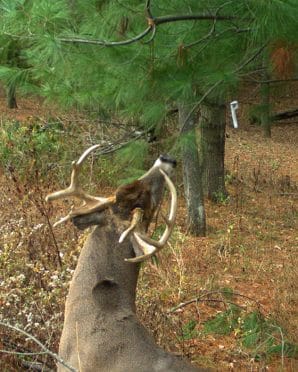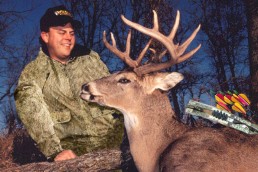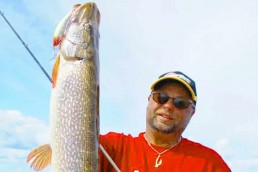Pulling the Wool over a Whitetail’s Nose
SHARE THIS POST
As many of you know, I love the challenge of using scent to try and fool a whitetail’s sense of smell—especially if they’re mature bucks. I’ve had phenomenal luck using scent for whitetails. The following are three proven tactics that are my favorites.
Train the buck to show up when you are there
“Mock Scrapes” could be an entire article series itself. There are so many variables, but timing and location are two of the most important. While mock scrapes can draw a response as soon as bucks lose their velvet in early September, I see better results from late September through the first week in November. Then, again, after the main surge of breeding has finished and through the end of the season. When the bucks are actively chasing and breeding, mock scrapes are probably not your best tactic.
Location is also a key. You can’t just use any tree with an overhanging branch and expect success. Concentrate on areas closer to bedding areas where you would naturally have a better chance at seeing a buck during legal light.
You want to target an area that a buck is claiming as his, then move in and make it look and smell like there’s a rival buck invading his turf. Look for areas with the largest scrapes, spots that contain numerous scrapes or clusters of scrapes, and scrapes that you know have been freshened again and again. Once you locate an area with activity, try to duplicate the variables the local bucks prefer.
Making your scrape stick
While bucks can make a scrape without one, most of the time an overhanging branch (most often referred to as a “licking branch”) is necessary to induce scrape activity. They interact with the licking branch by chewing on and/or licking it and scent marking it with their forehead and preorbital glands. The majority of scrapes are made underneath these licking branches, which are usually about five and a half feet off of the ground.
The actual ground scrape is made by the buck pawing the ground and whisking the leaves and dirt away. Then, the majority of the time, he will urinate down his hocks and over his tarsal glands into it. The order of these steps may vary from one buck to another.
Remember, the purpose of the mock scrape isn’t necessarily to get the buck to interact directly with the set; it’s to get them to show up during legal light and spend more time in the area. The best results I’ve had come from making a series of mock scrapes and using Magnum Scrape Drippers over them. My own, fake, scrape line. Magnum Scrape Drippers are heat-activated so they drip during daylight hours, conditioning bucks to show up during legal shooting light and stay in the area longer.
The new Super Charged Scrape Dripper has a higher output than the Magnum Dripper, to attract more deer traffic. The Super Charged Dripper will operate for about seven to twelve days on four ounces of scent. A regular Magnum Dripper will put out that same four ounces in about two to three weeks. In my view, both have their place.
Build your own, or borrow a buck’s
You can use a buck’s existing scrape since, in the whitetails’ world, the same scrape may be utilized by many different bucks. However, more often than not, I’ll make my own, trying to copy the specifics found with existing scrapes in the area.
The actual mock scrape is best created with a sturdy stick found in the area. Try to make the scrape on flat ground (if possible) and make sure it is free from all debris.
Are you enjoying this post?
You can be among the first to get the latest info on where to go, what to use and how to use it!
I prefer to use several drippers, each on their own scrape, and possibly vary the scent in each. I believe with more than one mock scrape, you’re increasing the chances that something’s going to be right with at least one of them that will draw a response. I’ve used as many as six drippers and created over a dozen mock scrapes in an area about the size of an acre. My three favorite scents are Active Scrape, Golden Scrape or Trail’s End #307 used in the dripper.
The path to success

While I enjoy making all kinds of scent setups, I would have to say that a simple scent trail has proven to be the most successful over the years. A Pro-Drag is the best tool that I have found to create a scent trail with, because it holds a lot of scent and it’s easy to control. You can use any type of liquid scent when making a trail. It doesn’t have to be a deer smell, you are alright to use food lures or curiosity scents, too. The Pro-Drag makes it easy to attach the drag line to a branch and drag the trail off of the exact path my feet are taking. Obviously, in thick brush this will be difficult. Wherever possible, I believe it leaves the most faultless trail possible for a buck to follow.
This type of drag also leaves the scent in contact with the ground almost continuously. It leaves a much easier trail for the buck to follow than boot pads. Boot pads are still a good way to leave a trail. But, with each step, you take the scent away from ground contact. With the Pro-Drag, the scent is in contact with the ground most of the time. So, the buck can put his nose to the ground and go to town. It’s also easy to control over fences or through wet areas.
Leaving a long, lingering trail
The type of scent you use may have an influence over the type of trail, the distance you leave it and the tools you use. When using deer smells like an estrus lure or buck urine, I will often leave long trails – sometimes close to ¾ of a mile or more. In fact, I’ve been known to drag trails right off of my ATV down a logging road – with success. Whitetails travel and/or cross these roads all the time, so it would be a natural route. And, bucks will often put on ten miles or more during a day in search for hot does. I’ve had long estrus trails work well during the rut. It can also work well for curiosity type lures and even food smells, but those scent trails I tend to make shorter. I guess they could be just as long, I just have never needed to. When making long trails, stop to reapply the scent from time to time to create an easy trail for your buck.
Keep it simple
A simple wick setup is designed to lure in deer from downwind. This is the easiest scent tactic that I know. Place out lure-soaked wicks crosswind from your position at your maximum confident shooting range. Maximum range is important. We want the smell to draw in the deer before they get directly downwind.
This setup can be created by using felt wicks like a Pro-Wick, Quik-Wiks, Key-Wick or even one of the heated scent dispensers on the market. This is also a great tactic to get your buck to stop in a shooting lane. I’ve arrowed mature bucks that have literally had their nose touching a lure-soaked wick.
The counterargument
I’ve heard naysayers comment that scent only works on younger bucks or does and fawns. I couldn’t disagree more. Every animal is unique and has a different personality. One buck may do a backflip and bolt away from a smell. The next buck may sit there for five minutes doing a lip-curl, relishing the same set.
It doesn’t matter what type of scent you use or how you set it up. If there are unnatural odors or danger smells present, all your work will go for not. Keep your setup free of foreign scent (the use of rubber gloves and Scent Killer Gold help dearly).
A hunter should use all other information in conjunction with your scent setups. Know where the does are bedding, what the preferred food sources are, where your target buck is bedding, and where he may have other scrape areas. Consider it all, collectively, before making your setup.
MWO
SHARE THIS POST
Did you enjoy this post?
You can be among the first to get the latest info on where to go, what to use and how to use it!
Todd Amenrud
Todd Amenrud is a full time sportsman whose passion is bowhunting whitetails. He spends considerable time researching whitetails, and has written six books on the subject. Harvesting 47 record-book animals and his ability to share his knowledge have made him one of the Midwest’s most-recognized hunting resources.



